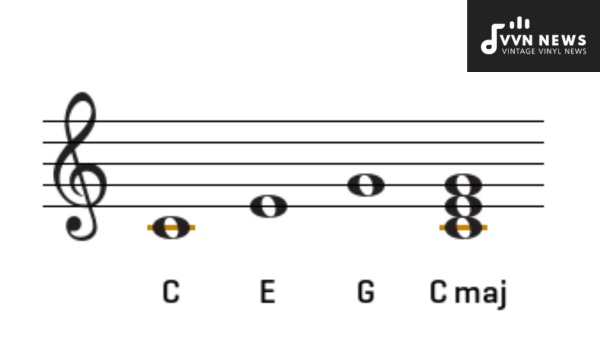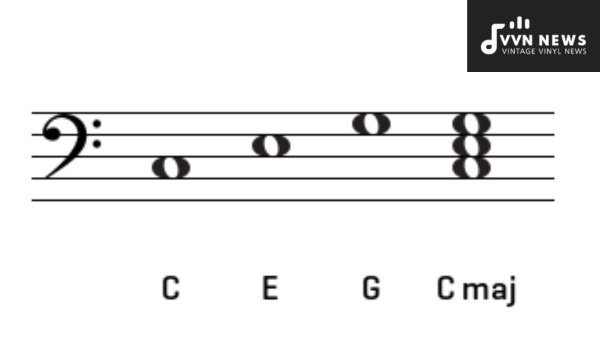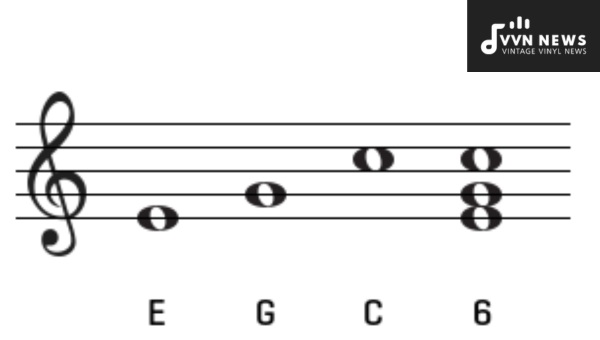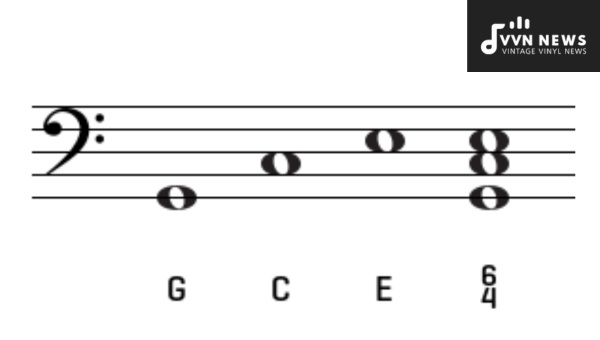Today, I’m excited to share with you a comprehensive guide to the C Major Triad in music theory.
Whether you’re a beginner trying to grasp the fundamentals or an experienced musician looking to expand your knowledge, this article will provide you with valuable insights into this fundamental aspect of music.
When it comes to understanding chords, the C Major Triad is an essential building block.
In this comprehensive guide, we will delve into what exactly a triad is and how it is constructed within the context of the C Major scale. You may be wondering what exactly a triad is.
Well put, it is a group of three notes played together that creates a harmonious sound. Specifically focusing on the C Major Triad, we will explore its structure, how it relates to the C Major scale, and how it can be applied in various musical contexts.
So, without further ado, let’s dive into this comprehensive guide to the C Major Triad in Music Theory!
What’s a Triad?
A triad, in music theory, is simply a chord made up of three different notes. These notes are played simultaneously to produce a harmonious sound.
The term “triad” essentially refers to the number three – three notes played together to create a chord. The basic triad consists of a root note, a third interval above the root note, and a fifth interval above the root note.
These intervals determine the quality of the triad (whether it is major, minor, augmented, or diminished). Triads form the foundation of chords in most styles of music and understanding them is crucial for any aspiring musician.
Why is the C Major Triad Important?

The C Major Triad holds significant importance in music theory for several reasons. Here are a few key points that highlight its importance:
- Rooted in the C Major Scale: The C Major Triad is derived from the C Major scale, which consists of the notes C, D, E, F, G, A, and B. As the triad’s name suggests, it centers around the note C as its root or tonic. Understanding and mastering this triad is crucial in understanding chords and progressions within the broader context of the C Major scale.
- Foundation for Other Chords: The C Major Triad serves as a foundation for many other chords. By understanding how to construct and use this basic triad shape, musicians can build upon it to create more complex and interesting chord progressions. It provides a solid base for branching out into more advanced musical concepts.
- Commonly Used in Music: The C Major Triad is one of the most commonly used chords in music across various genres and styles. Its simple yet pleasing sound lends itself well to creating melodic and harmonious compositions. By familiarizing oneself with this triad’s structure and sound, musicians can play a wide range of songs with ease.
- Transposition: Transposing music involves changing the key of a piece to accommodate different instruments or vocal ranges. Because the C Major Triad is widely recognized and understood, it serves as a reference point for transposing songs into different keys.
- Ear Training: Learning to identify and distinguish between different triads is an essential part of ear training – developing one’s ability to identify pitches and chords by ear alone. Mastering the sound of the C Major Triad will provide a solid foundation for ear training exercises and help develop a keen musical ear.
Also Read: B Major: The Scale And Chords [Guide To This Bold & Beautiful Key]
Construction of C Major Triad
The C Major Triad is built upon the C Major scale, consisting of the notes C, D, E, F, G, A, and B. To construct a C Major Triad, we take the root note (C), and then skip over the second note (D) to find the third note (E). Next, we skip over another note (F) to arrive at the fifth note (G). This gives us the three notes that make up the C Major Triad: C (the root), E (the major third), and G (the perfect fifth).
To represent this in musical notation or chord symbols, we use a capital “C” for the root note followed by a capital “M” for major and a lowercase “triad.” So, the C Major Triad can be written as “Cmaj” or simply “C.”
It’s important to remember that triads can be formed within any key or scale using a similar construction process. Understanding this process allows us to form triads in other keys as well.
Inversions of C Major

In music theory, inversions are a way to rearrange the notes of a chord. Triads can be inverted in order to give them a different sound and create more interesting chord progressions. The C Major Triad, consisting of the notes C, E, and G, can be inverted in three ways:
- Root Position: In root position, the root note (C) is at the bottom, followed by the third (E) and the fifth (G) above it.
- First Inversion: In first inversion, the third (E) becomes the lowest note, with the fifth (G) above it and the root note (C) on top.
- Second Inversion: In second inversion, the fifth (G) is at the bottom, with the root note (C) above it and the third (E) on top.
Each inversion changes the harmony of the chord while maintaining its essential character. This allows for smoother voice leading and can open up new possibilities for chord progressions and melodic lines.
Also Read: C Sharp Major Pentatonic Scale [Crisp & Clear Tones For Your Music]
D Flat Minor’s Inversions on Guitar & Piano
One of the key concepts in music theory is understanding chord inversions. A chord inversion refers to the reordering or rearranging of the notes within a chord, resulting in a different order of tones. In this section, we will explore the inversions of the D Flat Minor chord on both guitar and piano.
Guitar Inversions
When it comes to playing chord inversions on the guitar, it’s important to understand that each string represents a specific note. The D Flat Minor chord is formed by the notes Db, Fb, and Ab. Here are three common inversions of the D Flat Minor chord on guitar:
- Root position (Db – Fb – Ab): In this inversion, place your index finger on the 1st fret of the low E string for Db, your ring finger on the 4th fret of the A string for Fb, and your pinky finger on the 6th fret of the D string for Ab.
- First inversion (Fb – Ab – Db): For this inversion, place your index finger on the 2nd fret of the lowest E string for Fb, your middle finger on the 4th fret of A string for Ab, and your pinky finger over both strings 5 and 6 at 6th fret.
- Second inversion (Ab – Db – Fb): To play this inversion, position your index finger barred across strings 4 through 1 at the 4th fret for Ab, ring finger barred across strings 3 through 1 at 6th fret for Db, and pinky finger barring strings 3 through 1 at positions starting from root note located in upper position barres.
Piano Inversions
Playing inversions on piano is a bit different due to its keyboard layout. Here are the inversions of the D Flat Minor chord on the piano:
- Root position (Db – Fb – Ab): Place your thumb on Db, your middle finger on Fb, and your pinky finger on Ab.
- First inversion (Fb – Ab – Db): Start with your thumb on Fb, followed by your middle finger on Ab, and finally your pinky finger on Db.
- Second inversion (Ab – Db – Fb): Begin with your thumb on Ab, your middle finger on Db, and lastly, place your pinky finger on Fb.
Understanding and practicing chord inversions is essential for adding depth and variety to your musical compositions or improvisations. Experiment with these inversions in different musical contexts to see how they can enhance the overall sound of your playing.
C Major Triad Staff Notation

In music notation, the C Major Triad is represented by a combination of three specific symbols placed on a musical staff. Let’s break down the staff notation for the C Major Triad step by step:
- Start with a blank staff consisting of five horizontal lines and four spaces.
- Place a note on the bottom line of the staff, which represents the root note of C.
- Above this note, place another note that is two letter names higher in pitch, which represents the third interval of E.
- Above the second note, place one more note that is two letter names higher in pitch than the previous note, representing the fifth interval of G.
The resulting staff notation for the C Major Triad shows three notes stacked vertically on top of each other: C, E, and G from bottom to top.
Triads in C Major Scale
The C Major scale is a fundamental scale in music theory, consisting of the notes C, D, E, F, G, A, and B. Understanding the triads that can be derived from this scale is essential for building chords and harmonies.
Primary Triads
The primary triads in the C Major scale are formed by taking every other note from the scale. These triads include:
- C Major: Using the first (C), third (E), and fifth (G) notes of the scale, this triad produces a bright and cheerful sound. It is often associated with feelings of joy and happiness.
- D Minor: Using the second (D), fourth (F), and sixth (A) notes of the scale, this triad creates a somber and melancholic mood. It is commonly used to evoke emotions of sadness or introspection.
- E Minor: Using the third (E), fifth (G), and seventh (B) notes of the scale, this triad has a softer and more mellow sound. It is widely used in various genres to create emotional depth or contemplation.
Secondary Triads
The secondary triads in the C Major scale are formed by taking every other note from different starting points. These triads include:
- F Major, starting on the fourth note of the scale: F-A-C.
- G Major, starting on the fifth note of the scale: G-B-D.
- A Minor, starting on the sixth note of the scale: A-C-E.
- B Diminished, starting on the seventh note of the scale: B-D-F.
Understanding these primary and secondary triads in C Major will provide a solid foundation for chord progressions and musical compositions. Experiment with combining these triads to create your own unique sounds.
Also Read: F Sharp Major Scale [Add Unique Tones To Your Musical Palette]
Common C Major Triad Progressions

Progressions are a fundamental aspect of music composition and understanding the common progressions involving the C Major Triad can greatly enhance your musical repertoire. Here are some of the most common progressions in the key of C Major:
- I-IV-V Progression: This is one of the most popular progressions in music. It involves using the C Major Triad (I), F Major Triad (IV), and G Major Triad (V). This progression is often heard in pop, rock, and blues music.
- I-IV-I-V Progression: Similar to the previous progression, this one adds an extra I chord between the IV and V chords. So it would go C Major (I), F Major (IV), C Major (I), G Major (V). This progression is commonly used in folk, country, and gospel genres.
- I-vi-IV-V Progression: This progression adds a minor chord to the mix. It includes the C Major Triad (I), A Minor Triad (vi), F Major Triad (IV), and G Major Triad (V). It is frequently used in ballads, pop, and R&B music.
- ii-V-I Progression: In this progression, you will be using the D Minor Triad (ii), G Major Triad (V), and C Major Triad (I). This progression is commonly found in jazz and classical music.
It’s important to note that these progressions are just a starting point, and there are countless variations you can explore. Experimenting with different chord voicings, inversions, and rhythm patterns will allow you to create your own unique sound.
Popular Songs of The C Major Triad
As a musician, it’s always exciting to apply music theory concepts to actual songs.
The C Major Triad, being one of the most fundamental chords in music, is present in numerous popular songs across different genres. Let’s explore some well-known tunes that prominently feature the C Major Triad.
- “Let It Be” by The Beatles: This timeless classic begins with a C Major Triad arpeggio, setting the foundation for the song’s uplifting melody and message. The simple and elegant use of the triad creates a sense of optimism and comfort.
- “Sweet Child o’ Mine” by Guns N’ Roses: In this iconic rock anthem, you can hear the raw power of the C Major Triad throughout the verses and choruses. The guitar riff that kicks off the song is based on a repeated sequence of C Major Triads, giving it its memorable sound.
- “Viva la Vida” by Coldplay: This chart-topping hit features an instantly recognizable melody built around the C Major Triad. It showcases how a simple triadic structure can be transformed into a captivating and emotionally evocative tune.
- “Hallelujah” by Leonard Cohen: This hauntingly beautiful ballad uses the C Major Triad to great effect, emphasizing its melancholic and introspective mood. Cohen’s gripping lyrics are complemented by the simplicity and resonance of this chord progression.
- “Hey Jude” by The Beatles: Another masterpiece from The Beatles, “Hey Jude” incorporates the C Major Triad prominently in its chorus sections. Paul McCartney’s soaring vocals are accompanied by a powerful piano line that revolves around this foundational chord.
- “Wagon Wheel” by Old Crow Medicine Show: This popular folk-country tune showcases the versatility of the C Major Triad within different musical genres. From acoustic guitar strumming to banjo picking, the triad forms the backbone of this catchy and infectious song.
- “Clocks” by Coldplay: In this modern classic, the C Major Triad is used in an arpeggiated piano riff that repeats throughout the entire track. It creates a mesmerizing and hypnotic effect that captures the listener’s attention from start to finish.
These are just a few examples of popular songs that prominently feature the C Major Triad.
By studying these songs and analyzing how this foundational chord is utilized, you can gain a deeper understanding of its versatility and application in different musical contexts.
Also Read: B Flat Major Scale [Exploring This Warm & Mellow Key]
FAQs About C Major Triad
What is the difference between a major and a minor triad?
A major triad consists of a root note, a major third interval, and a perfect fifth interval. A minor triad consists of a root note, a minor third interval, and a perfect fifth interval.
How is the C Major Triad constructed?
The C Major Triad is constructed using the notes C, E, and G. It consists of the root note (C), the major third interval (E), and the perfect fifth interval (G).
Can I play the C Major Triad in different positions on the guitar?
Yes, you can play the C Major Triad in different positions on the guitar by shifting the position of your fingers on the fretboard while maintaining the same three notes (C, E, G).
Are there any songs that prominently feature the C Major Triad?
Yes, many popular songs prominently feature the C Major Triad. Some examples include “Hey Jude” by The Beatles and “Piano Man” by Billy Joel.
How can I use the C Major Triad in my own songwriting or improvisation?
The C Major Triad can be used as a starting point for creating melodies and harmonies in your own songwriting or improvisation. Experiment with different rhythmic patterns and combinations to create unique musical ideas using this fundamental chord structure.
Conclusion
The C Major Triad in music theory is a fundamental aspect for any musician.
In this comprehensive guide, we have explored what a triad is and how it is constructed within the context of the C Major scale.
We have discussed the different inversions of the C Major Triad and how it can be represented in staff notation.
We have looked at the significance of triads in the broader context of the C Major scale and how they can be used in common chord progressions.
By mastering the C Major Triad, you will gain a solid foundation in music theory and open up endless possibilities for creating beautiful harmonies.
So go ahead, dive into the world of triads, practice diligently, and let your musical creativity soar.








